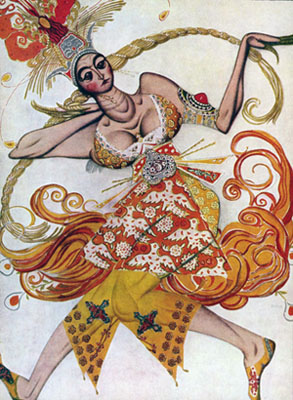Unit 3:
A Silver Age of Russian Culture
An illustration of the Firebird costume designed by Lev Bakst (Lev Rosenberg, 1866-1924), one of the primary stage designers for the Ballets Russes of Sergei Diagilev (1872-1929). Bakst begin painting in the 1890s and became associated with the Mir iskusstva (World of Art) art movement in Russia where he worked on the path-breaking journal for the movement. He was an absolute brilliant illustrator and one of the key figures in the Russian "Silver Age."

- Read the textbook chapter 33.
- Check the remarks by Professor Blois and Professor Evans on Russia's Silver Age.
- Study the Questions to Consider and the Key Terms for the Unit.
- Post (or respond) your thoughts/ideas about this Unit's reading and assignment in the Blackboard online discussion forum. Do not post your assignment there.
- These chapters from Russia of the Russians offer a contemporary assessment of Russian cultural accomplishments in these different areas during the Silver age:
- Anton Chekhov
- Maxim Gorky FilmImages.mp4
- Stravinsky - Ballets Russes - Sacre du printemps – Firebird
- The Golden Age of Art - Celebrating 100 Years of the Ballets Russes
- Arts.21 | Dance Revolution The Ballets Russes Turns 100
- Tamara Karsavina - Ballets Russes Prima Ballerina
- Ballets Russes archive footage found
- For extra credit please suggest to your instructor a relevant video for this unit of the course. Send the title of the video, the url and a brief explanation of why you find the video interesting and applicable to the material that is being studied in this unit.
- For 50 points maximum extra credit, watch Dama S Sobachkoy (The Lady with the Little Dog) and write a one-page paper about the "little dog."
- For 50 points maximum extra credit (maybe more), visit Hillwood Estate, Museum & Gardens and comment on the Faberge eggs and the Russian art collection there as respresentative of the Russian Silver Age.
- For 50 points maximum extra credit, watch Neokonchenaya Piesa dlia Mekhanicheskogo
Pianino (Unfinished Piece for the Player Piano) and write a one-page paper of what was so fascinating in the movie.
- For 50 points maximum extra credit, listen to Igor Stravinskii's The Rite of Spring--You can watch the version in Fantasia (1940) and write a one-page paper in which you explain the historical impact of this piece.
- For
50 points maximum extra credit, watch a production of one of the
performances/choreographies of Diagilev's Ballets Russes and write a one-page paper in which you explain to
me what you found so exciting.
- For 50 points maximum extra credit, read John Bowlt, The Silver Age (1982) and write a one-page paper describing the author's identification of the main features of the Silver Age.
- For 50 points maximum extra credit, read Aleksandr Blok (1880-1921), Verses on a Beautiful Lady (1904) and write a one-page paper describing some of the main themes of the poems in the context of Russian symbolism.
- For 50 points maximum extra credit, read Maksim Gorkii (1868-1936), Mother (1906) and write a one-page paper in which you answer the question, "How did Gorkii portray elements of Russian society previously not found suitable for the Russian reading public?"
- For 50 points maximum extra credit, read Mikhail Artsybashev, Sanin (1908) and write a one-page paper explaining what Russian society found so offensive about the novel.
- For 50 points maximum extra credit, read Anton Chekhov (1860-1904), Uncle Vanya (1899) or The Cherry Orchard (1904) and write a one-page paper comparing Chekhov's work to that of Henrik Ibsen (1828-1906).
- For 25 points maximum extra credit, after looking through some of the recommended websites for the Unit, write a long paragraph that identifies some of the unifying features of the Russian silver age.